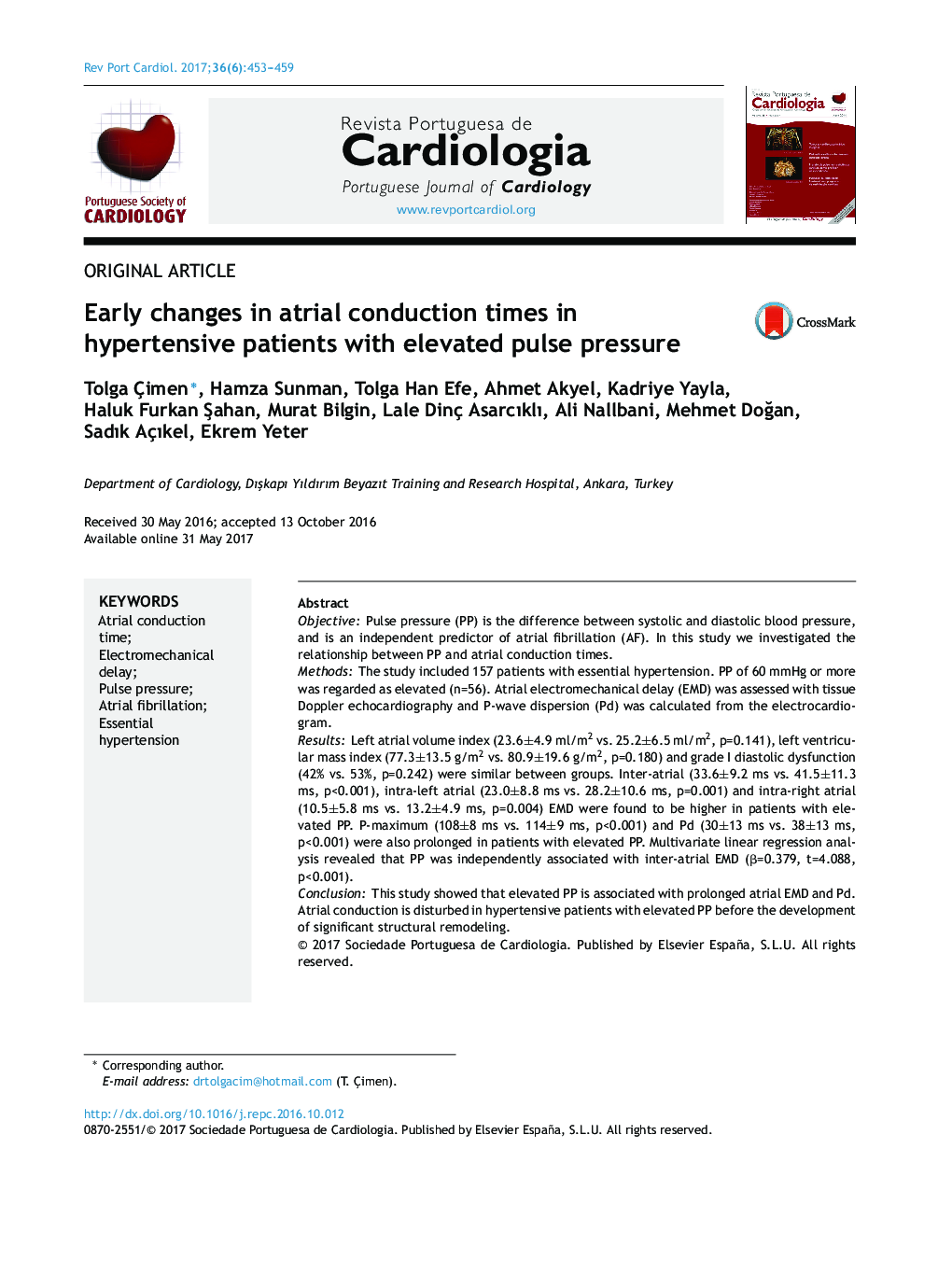| کد مقاله | کد نشریه | سال انتشار | مقاله انگلیسی | نسخه تمام متن |
|---|---|---|---|---|
| 5126405 | 1378496 | 2017 | 7 صفحه PDF | دانلود رایگان |
ObjectivePulse pressure (PP) is the difference between systolic and diastolic blood pressure, and is an independent predictor of atrial fibrillation (AF). In this study we investigated the relationship between PP and atrial conduction times.MethodsThe study included 157 patients with essential hypertension. PP of 60 mmHg or more was regarded as elevated (n=56). Atrial electromechanical delay (EMD) was assessed with tissue Doppler echocardiography and P-wave dispersion (Pd) was calculated from the electrocardiogram.ResultsLeft atrial volume index (23.6±4.9 ml/m2 vs. 25.2±6.5 ml/m2, p=0.141), left ventricular mass index (77.3±13.5 g/m2 vs. 80.9±19.6 g/m2, p=0.180) and grade I diastolic dysfunction (42% vs. 53%, p=0.242) were similar between groups. Inter-atrial (33.6±9.2 ms vs. 41.5±11.3 ms, p<0.001), intra-left atrial (23.0±8.8 ms vs. 28.2±10.6 ms, p=0.001) and intra-right atrial (10.5±5.8 ms vs. 13.2±4.9 ms, p=0.004) EMD were found to be higher in patients with elevated PP. P-maximum (108±8 ms vs. 114±9 ms, p<0.001) and Pd (30±13 ms vs. 38±13 ms, p<0.001) were also prolonged in patients with elevated PP. Multivariate linear regression analysis revealed that PP was independently associated with inter-atrial EMD (β=0.379, t=4.088, p<0.001).ConclusionThis study showed that elevated PP is associated with prolonged atrial EMD and Pd. Atrial conduction is disturbed in hypertensive patients with elevated PP before the development of significant structural remodeling.
ResumoObjetivosA pressão do pulso (PP) é a diferença entre as pressões sistólica e diastólica, e é um preditor independente da fibrilhação auricular. Neste estudo, investigamos a relação entre a PP e os tempos de condução auricular.MétodosO estudo incluiu 157 doentes com hipertensão essencial. Uma PP de 60 mmHg ou superior foi considerada elevada (n=56). O atraso eletromecânico auricular foi avaliado através de ecocardiografia Doppler tecidular e a dispersão da onda P foi calculada através de eletrocardiograma.ResultadosO Ãndice do volume auricular esquerdo (23,6±4,9 mL/m2versus 25,2±6,5 mL/m2, p=0,141), o Ãndice da massa ventricular esquerda (77,3±13,5 g/m2versus 80,9±19,6 g/m2, p=0,180) e a relação da disfunção diastólica grau I (42 versus 53%, p=0,242) foram semelhantes entre os grupos. Um atraso eletromecânico auricular inter (33,6±9,2 ms versus 41,5±11,3 ms, p<0,001), intraesquerdo (23,0±8,8 ms versus 28,2±10,6 ms, p=0,001) e intradireito (10,5±5,8 ms versus 13,2±4,9 ms, p=0,004) foram considerados superiores nos doentes com PP elevada. Uma pressão máxima (108±8 ms versus 114±9 ms, p<0,001) e uma dispersão da onda P (30±13 ms versus 38±13 ms, p<0,001) foram também prolongados nos doentes com PP elevada. Uma análise multivariada de regressão linear revelou que a PP estava independentemente associada ao atraso eletromecânico auricular (β=0,379, t=4,088, p<0,001).ConclusãoEste estudo mostrou que a PP elevada está associada ao prolongamento do atraso eletromecânico auricular e da dispersão da onda P. A condução auricular revela mais alterações nos doentes hipertensos com PP elevada antes do desenvolvimento de remodelagem estrutural significativa.
Journal: Revista Portuguesa de Cardiologia - Volume 36, Issue 6, June 2017, Pages 453-459
